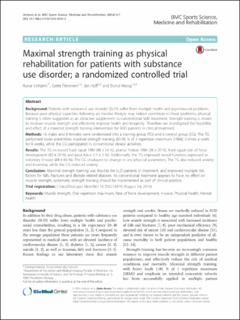Maximal strength training as a physical rehabilitation for patients with substance use disorder; a randomized controlled trial
Peer reviewed, Journal article
Published version

Åpne
Permanent lenke
https://hdl.handle.net/11250/2657073Utgivelsesdato
2016Metadata
Vis full innførselSamlinger
- Institutt for sirkulasjon og bildediagnostikk [1901]
- Publikasjoner fra CRIStin - NTNU [38053]
- St. Olavs hospital [2505]
Originalversjon
BMC sports science, medicine and rehabilitation. 2016, 8 (7), . 10.1186/s13102-016-0032-2Sammendrag
Background:Patients with substance use disorder (SUD) suffer from multiple health and psychosocial problems.Because poor physical capacities following an inactive lifestyle may indeed contribute to these problems, physicaltraining is often suggested as an attractive supplement to conventional SUD treatment. Strength training is shownto increase muscle strength and effectively improve health and longevity. Therefore we investigated the feasibilityand effect of a maximal strength training intervention for SUD patients in clinical treatment.Methods:16 males and 8 females were randomized into a training group (TG) and a control group (CG). The TGperformed lower extremities maximal strength training (85-90 % of 1 repetition maximum (1RM)) 3 times a weekfor 8 weeks, while the CG participated in conventional clinical activities.Results:The TG increased hack squat 1RM (88 ± 54 %), plantar flexion 1RM (26 ± 20 %), hack squat rate of forcedevelopment (82 ± 29 %) and peak force (11 ± 5 %). Additionally, the TG improved neural function, expressed asvoluntary V-wave (88 ± 83 %). The CG displayed no change in any physical parameters. The TG also reduced anxietyand insomnia, while the CG reduced anxiety.Conclusion:Maximal strength training was feasible for SUD patients in treatment, and improved multiple riskfactors for falls, fractures and lifestyle related diseases. As conventional treatment appears to have no effect onmuscle strength, systematic strength training should be implemented as part of clinical practice.